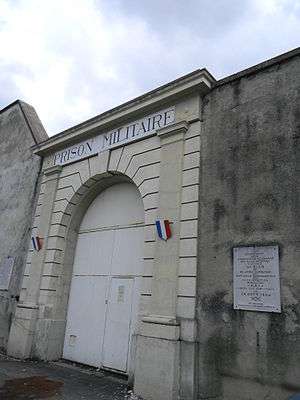Montluc prison
|
Entrance to the prison | |
| Location | Lyon, France |
|---|---|
| Coordinates | 45°45′1.37″N 4°51′42.61″E / 45.7503806°N 4.8618361°ECoordinates: 45°45′1.37″N 4°51′42.61″E / 45.7503806°N 4.8618361°E |
| Status | Museum |
| Opened | 1921 |
| Closed | 1997 |
| Street address | 4 rue Jeanne Hachette |
| City | Lyon |
| Country | France |
Montluc prison is a former prison located on rue Jeanne Hachette in the 3rd arrondissement of Lyon, France. It was known for being a internment, torture and killing place by the Gestapo during the occupation of France by the Nazis.
History
Built in 1921 for use as a military prison, after the invasion of the unoccupied zone of Vichy France in November 1942, the Gestapo used it as a prison, interrogation centre and internment camp for those waiting for transfer to concentration camps. It is estimated that over 15,000 people were imprisoned in Montluc, and over 900 of them were executed within it.[1]
In mid-August 1944, prisoners from Montluc were taken to Bron Airfield where 109 of them, including 72 Jews, were killed in what would become known as Le Charnier de Bron ("The Charnel house of Bron").[2]
Montluc was liberated on 24 August 1944 by FFI troops, when resistance leader Colonel Köenig, profiting from the chaos reigning in Lyon at the time, entered the prison in a stolen German Army car disguised as a Gestapo officer and persuaded the Commandant to free the prisoners, saying that the order had come from the Gestapo Commander in Lyon, Klaus Barbie.[1]
In 1947, Montluc became a civil prison once again, finally closing in 1997,[3] though the female maison d'arrêt was not closed until May 2009.
Current status
In 2009, most of the prison, including the walls, the stairs and the courtyard, were classified as a monument historique.[4] Since September 2010 the prison has been open to the public for guided tours organized by the National Office of Veterans and War Victims (l’Office national des Anciens combattants et Victimes de guerre).[5]
Notable prisoners
- Raymond Aubrac, resistance leader (1943)
- Anthony Brooks, British SOE officer (1944)
- Marc Bloch, historian and resister (1944)
- Habib Bourguiba, Tunisian nationalist, later 1st President of Tunisia (1943)
- André Devigny, soldier and resister who escaped (1943)
- Salomon Gluck, physician and resister (1944)
- Maurice Joyeux, anarchist (1940–44)
- Jean de Lattre de Tassigny, later commander of 1st French Army during the invasion of Southern France (1942–43)
- Jean Moulin, soldier and resistance leader (1943)
- Élise Rivet, nun and resister (1944)
- Andre Frossard, French journalist and essayist, interned in the "Jew Booths" of Fort Montluc; one of seven survivors of Bron Massacre (1943-44)
See also
References
- 1 2 Cosgrove, Michael (24 August 2009). "Lyon commemorates the liberation of its wartime Nazi prisoners". Digital Journal. Retrieved 7 June 2010.
- ↑ "Bron: le panneau en mémoire des charniers de l'aéroport dévoilé" [Bron: memorial unveiled to mass graves at the airport]. Le Progrès. 2 September 2014. Retrieved 26 June 2015.
- ↑ "Les prisons de Lyon". Prison.eu (in French). Retrieved 7 June 2010.
- ↑ "Monuments historiques — Fort Montluc" (in French). Mérimée. Retrieved 20 September 2010.
- ↑ "Prison de Montluc : un nouveau lieu de mémoire". pointsdactu.org (in French). 2014. Retrieved 22 October 2014.
External links
![]() Media related to Prison Montluc at Wikimedia Commons
Media related to Prison Montluc at Wikimedia Commons
